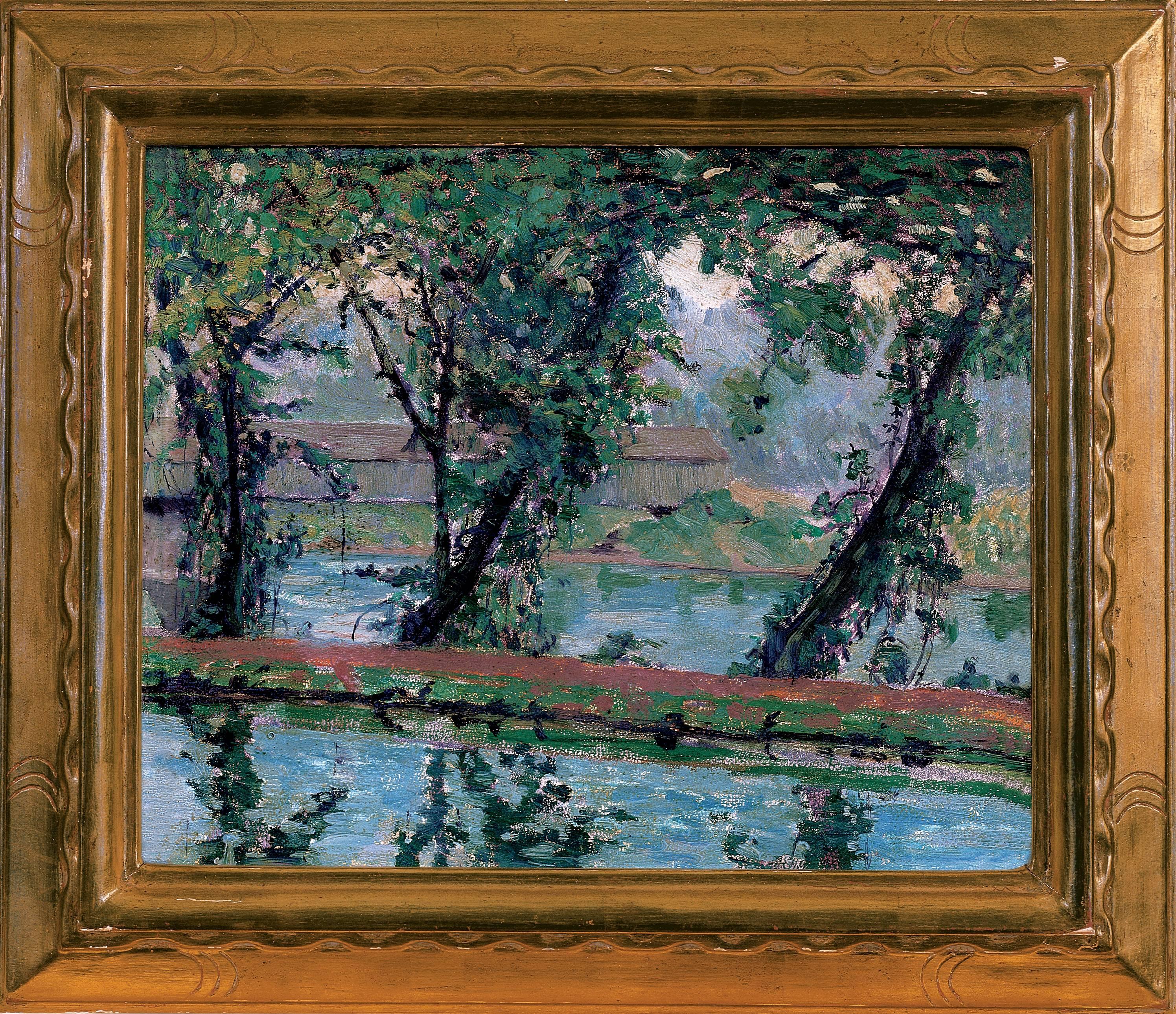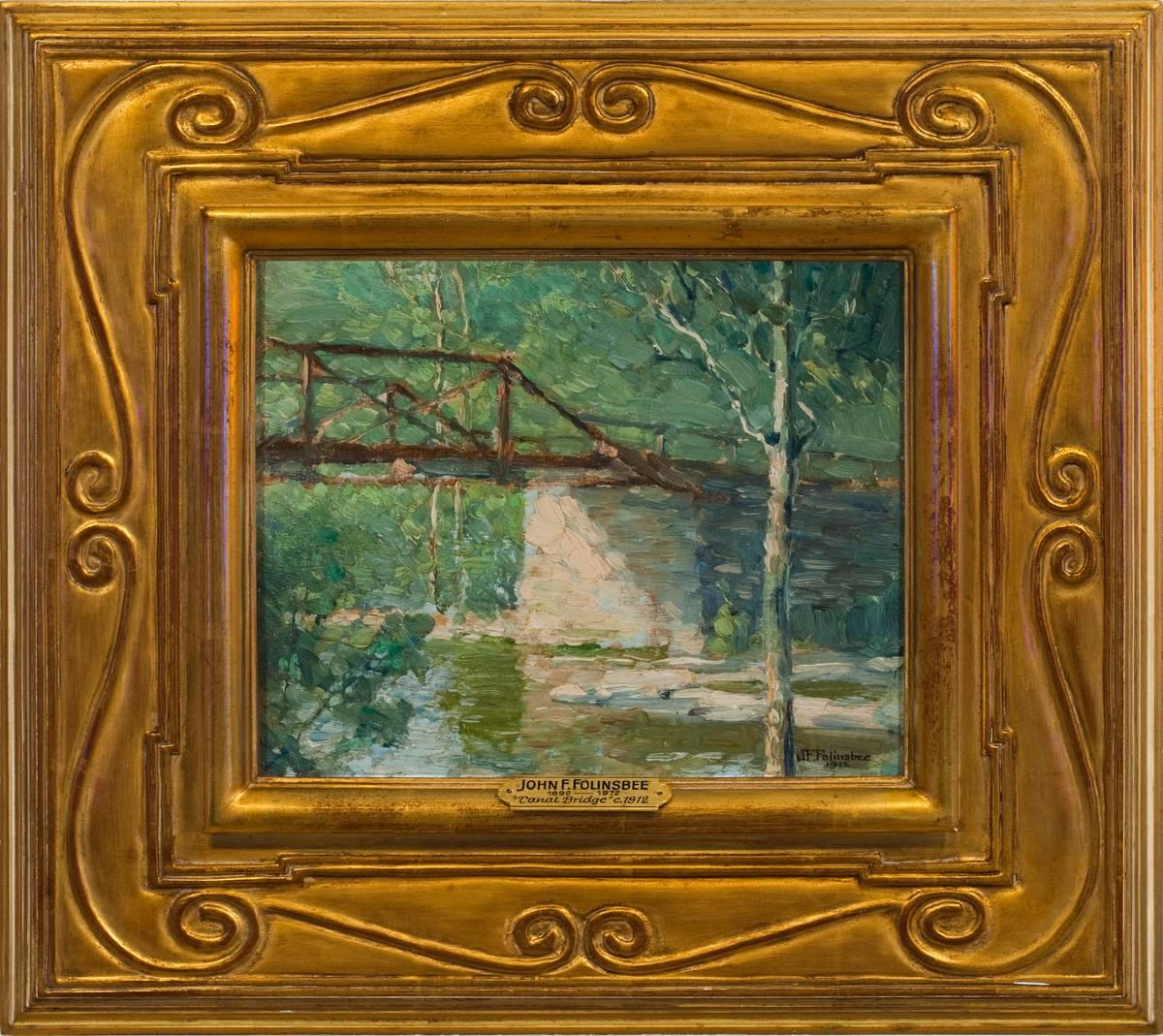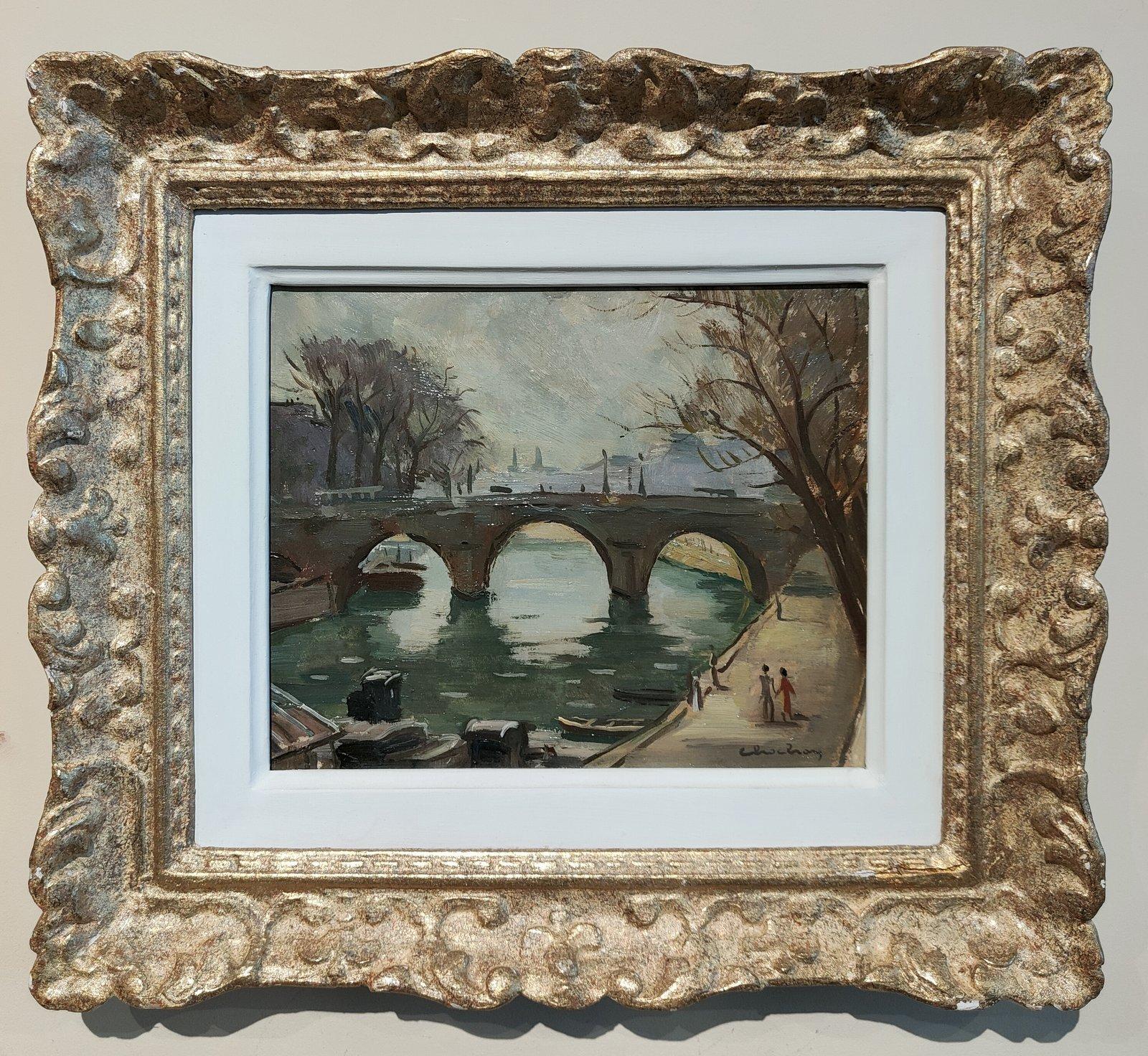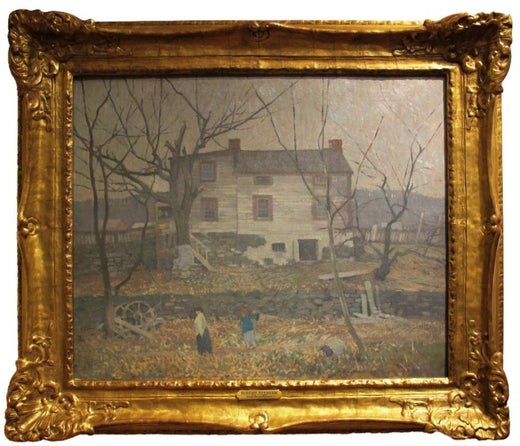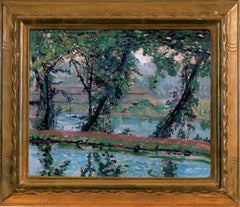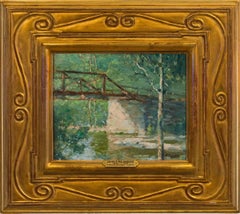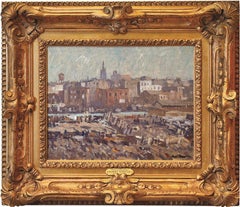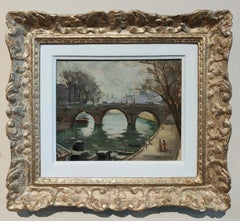Items Similar to "The Gray Bridge"
Want more images or videos?
Request additional images or videos from the seller
1 of 5
Robert Spencer"The Gray Bridge"Circa 1925
Circa 1925
$24,375
£18,513.41
€21,293.81
CA$34,056.65
A$37,977.02
CHF 19,814.79
MX$465,992.37
NOK 252,210.72
SEK 238,964.18
DKK 158,923.59
Shipping
Retrieving quote...The 1stDibs Promise:
Authenticity Guarantee,
Money-Back Guarantee,
24-Hour Cancellation
About the Item
Jim’s of Lambertville is proud to offer this artwork by:
Robert Spencer (1879 - 1931)
One of the rarest and most important artists among the New Hope School, Robert Spencer was born in Harvard, Nebraska. Living an itinerant lifestyle as a youth, Spencer ended up in New York by his teenage years. After graduating high school, he attended classes at the National Academy of Design in New York in 1899. From 1903 to 1905, he continued his studies at the New York School of Art under William Merritt Chase and Robert Henri.
From 1906 through 1910, Spencer lived in towns in close proximity to the Delaware River, such as Frenchtown, New Jersey and Point Pleasant, Pennsylvania. He spent the summer of 1909 studying with Daniel Garber at his home in Lumberville. Soon after, Spencer moved to New Hope, where for the sake of conserving money, he roomed with fellow artist Charles Ramsey. The two impoverished artists rented the dilapidated old Huffnagle Mansion for two dollars a month. It was there that Spencer’s career would begin to take shape. His studio was set up in the massive ballroom just a stone’s throw away from the Heath and Maris mills. The mansion was originally built for Richard Heath in 1707, who at the time owned the Heath Grist Mill. It was later bought by William Maris in 1802, who owned the Maris Silk Mill. These two mills provided subject matter for some of Spencer’s most important paintings and elements from them continued to appear in his paintings for year after. Spencer became famous for his scenes of mills, tenements, and factories. One of his most praised depictions of working-class life is “Repairing the Bridge”, which was purchased by the Metropolitan Museum of Art in 1914.
In 1913, Spencer met Margaret Fulton, an artist and architect, and niece of well-known landscape painter, Birge Harrison. At the time, Margaret was studying with William Lathrop at his Phillips Mill home where Spencer often visited. A relationship developed and they married in 1914. For a while after, the Spencers moved across the river to nearby Lambertville, where they lived above the firehouse. In 1916, they bought a home in Rabbit Run, midway between New Hope and Phillips Mill where Spencer remained until his untimely death. In 1931, Robert Spencer, suffering from bouts of depression and an unhealthy marriage, took his own life.
Spencer exhibited extensively in the United States and abroad, garnering numerous prizes, including the Hallgarten Prize, the Inness Award, and the Gold Medal from the Pennsylvania Academy of the Fine Arts.
His work is in the permanent collections of the Art Institute of Chicago, the Metropolitan Museum of Art, the James A. Michener Art Museum, the Brooklyn Museum, the Smithsonian Institute, the Corcoran Gallery of Art, the Philadelphia Museum of Art, the National Academy of Design, the Reading Public Museum, the Detroit Institute of Fine Arts, the National Arts Club, the Delaware Art Museum, and the Phillips Collection in Washington, D.C., among others.
- Creator:Robert Spencer (1879-1931, American)
- Creation Year:Circa 1925
- Dimensions:Height: 22 in (55.88 cm)Width: 24 in (60.96 cm)Depth: 3 in (7.62 cm)
- More Editions & Sizes:Frame Size 20" x 22" x 2.5"Price: $24,375
- Medium:
- Movement & Style:
- Period:
- Condition:
- Gallery Location:Lambertville, NJ
- Reference Number:Seller: JOL110818017a1stDibs: LU3743748761
Robert Spencer
Biography from Anderson Galleries Photo of Robert Spencer Robert Spencer was born in 1879 in Nebraska, the son of a Swedenborgian minister. After studying medicine briefly, he decided to become an artist and moved to New York City, where he enrolled at the National Academy of Design. Later he studied with William Merritt Chase and Robert Henri at the New York School of Art. He moved to New Hope, Bucks County in 1906, and studied privately with the well-known Bucks County painter Daniel Garber. It was at the home of painter William L. Lathrop that Spencer met his future wife, Margaret Fulton, herself an accomplished architect. For the next 25 years Spencer lived and worked in Bucks County, becoming one of the most prominent members of the Pennsylvania Impressionist art colony. He suffered several nervous breakdowns in the 1920s, and in 1931 took his own life. Spencer became one of the most visible artists in the New York art world in the teens. His first success came in 1914, when the Metropolitan Museum of Art purchased one of his major early canvases, "Repairing the Bridge". The celebrated collector Duncan Phillips then took an interest in Spencer's work, eventually purchasing eight of Spencer's canvases, currently housed in the Phillips Collection in Washington, DC. The two men became friends, and Phillips appointed Spencer to the Committee on Scope and Plan of the new gallery then being created by Phillips. After Spencer's death, Phillips praised Spencer as "a rebel always against the standardized and stereotyped in art." Phillips believed that "there [was] no other painter, not John Sloan or Edward Hopper, more pungently American in expression." Spencer also has work in the collections of the Brooklyn Museum, the Carnegie Institute, the Corcoran Gallery of Art, and the Detroit Institute of the Arts. In 1915, he won a gold medal at the prestigious Panama-Pacific International Exposition in San Francisco. Stylistically, Spencer differed radically from most of his Pennsylvania Impressionist colleagues. Probably influenced by Henri and the Ashcan School, Spencer made his reputation with skillful, evocative renderings of the everyday life of his community, often depicting the mills, tenements, and factories of New Hope and surrounding areas. "A landscape without a building or a figure, " he said, " is a very lonely picture to me." Later Spencer painted more fanciful European scenes, many of which he did from his imagination, since he did not actually travel to Europe until 1925. Spencer's painting "Mountebanks and Thieves" won a prize at the 1926 Carnegie International Exhibition in Pittsburgh, and juror Pierre Bonnard said, "Mr. Spencer . . . is in the full vigor of his talent which is great. His art does not resemble European art, a rare fact in America."
About the Seller
5.0
Vetted Professional Seller
Every seller passes strict standards for authenticity and reliability
Established in 1997
1stDibs seller since 2014
38 sales on 1stDibs
- ShippingRetrieving quote...Shipping from: Lambertville, NJ
- Return Policy
Authenticity Guarantee
In the unlikely event there’s an issue with an item’s authenticity, contact us within 1 year for a full refund. DetailsMoney-Back Guarantee
If your item is not as described, is damaged in transit, or does not arrive, contact us within 7 days for a full refund. Details24-Hour Cancellation
You have a 24-hour grace period in which to reconsider your purchase, with no questions asked.Vetted Professional Sellers
Our world-class sellers must adhere to strict standards for service and quality, maintaining the integrity of our listings.Price-Match Guarantee
If you find that a seller listed the same item for a lower price elsewhere, we’ll match it.Trusted Global Delivery
Our best-in-class carrier network provides specialized shipping options worldwide, including custom delivery.More From This Seller
View All"The Bridge to Stockton"
By Alice B. Sotter
Located in Lambertville, NJ
Jim’s of Lambertville is proud to offer this artwork.
Complemented by original Ben Badura Frame
Illustrated in "New Hope for America Art" page 499
Sig...
Category
20th Century American Impressionist Landscape Paintings
Materials
Oil, Board
"Canal Bridge"
By John Fulton Folinsbee
Located in Lambertville, NJ
Jim’s of Lambertville Fine Art Gallery is proud to present this piece by John Fulton Folinsbee (1892 - 1972).
One of the finest painters to embark upon the New Hope Art Colony, John...
Category
1910s American Impressionist Landscape Paintings
Materials
Oil, Board
"The Gray House"
By Robert Spencer
Located in Lambertville, NJ
Jim’s of Lambertville is proud to offer this artwork by:
Robert Spencer (1879 - 1931)
One of the rarest and most important artists among the New Hope School, Robert Spencer was bo...
Category
1910s American Impressionist Landscape Paintings
Materials
Canvas, Oil
"Note of the City"
By Robert Spencer
Located in Lambertville, NJ
Jim’s of Lambertville is proud to offer this artwork.
Signed lower right
Period frame
Robert Spencer (1879 - 1931)
One of the rarest and most important artists among the New Hope...
Category
20th Century American Impressionist Paintings
Materials
Canvas, Oil
"River and Bridge"
By Gershon Benjamin
Located in Lambertville, NJ
Jim’s of Lambertville is proud to offer this artwork by:
Gershon Benjamin (1899-1985)
An American Modernist of portraits, landscapes, still lives, and the urban scene, Gershon Benj...
Category
1970s Landscape Paintings
Materials
Canvas, Oil
"River Above New Hope"
By Joseph Barrett
Located in Lambertville, NJ
Illustrated in "Joseph Barrett, The Prime Years 1970s - 1990s", pg. 41, plate #047
Jim’s of Lambertville is proud to offer this artwork by:
Joseph Barrett (1936 – )
Joseph Barrett was born in Midland, North Carolina, in 1936 and studied at the Massachusetts College of Art in Boston and at the Tyler School of Art in Philadelphia. Barrett, now of Lahaska, Pennsylvania, has been painting his entire adult life. His favorite subjects include the landscape surrounding New Hope and many local landmarks often encompassing figures into his compositions. Barrett utilizes a heavy impasto and his palette bears similarities to that of Fern Coppedge and George Sotter. Barrett’s paintings are always found in unique and somewhat charming handmade frames designed by the artist and finished in metal leaf.
A living contemporary of the no longer living “New Hope School” impressionist painters, Joseph Barrett resides outside of New Hope above his old-fashioned antique shop and studio. Entering Barrett’s shop is like taking a step back in time. Inside this cluttered and dusty haven of treasures from the past, is a studio spanning only four by eight feet. This little studio, containing cans of old brushes and hundreds of used paint tubes...
Category
Late 20th Century American Impressionist Landscape Paintings
Materials
Canvas, Oil
You May Also Like
Landscape with Bridge
Located in San Francisco, CA
This artwork "Landscape with Bridge" c.1980, is an oil painting on canvas board by American artist David P. Curtis. It is signed at the lower right corner. The canvas board size is 12 x 16 inches, framed size is 15.5 x 19.5 inches. Framed in original wooden light...
Category
Late 20th Century American Impressionist Landscape Paintings
Materials
Oil
Under the Bridge
Located in San Francisco, CA
This artwork "Landscape with Bridge" c.1970 is an oil painting on canvas by American artist Bert Pumphrey, 1916-2000. It is signed at the lower left corner by the artist. The canvas ...
Category
Late 20th Century American Impressionist Landscape Paintings
Materials
Oil
Pont Neuf Bridge, France 1906
By Clarence Keiser Hinkle
Located in Sheffield, MA
Clarence Keiser Hinkle
American, 1880-1960
Pont Neuf Bridge, France 1906
Oil on board
10 ¾ by 13 ¾ in, w/ frame 18 by 21 in
Signed lower right
An academy trained California painter...
Category
Early 1900s American Impressionist Landscape Paintings
Materials
Oil
Oil Painting by Andre Eugene Louis Chochon "Bridge over the Seine"
Located in Mere, GB
Oil Painting by Andre Eugene Louis Chochon "Bridge over the Seine" 1910 -2005 Studied Beaux Arts in Reines then exhibited at the society des Artistes. Francois from 1933, Grand Prix ...
Category
1950s Landscape Paintings
Materials
Oil
Antique French Impressionist Oil Grey Bridge Riverside Landscape through Town
Located in Cirencester, Gloucestershire
The Riverside Town
French Impressionist, early 1900's
oil on beveled wood panel, framed
panel: 9 x 14 inches
Provenance: private collection, France
Condition: very good condition
D...
Category
Early 20th Century Impressionist Landscape Paintings
Materials
Oil
Bridge Nocturne oil painting by Johann Berthelsen
By Johann Berthelsen, 1883-1972
Located in Hudson, NY
One of Johann Berthelsen's iconic nocturne views of New York City across the Hudson River.
Bridge Nocturne (c.1945)
Oil on canvas, 22" x 28"
29 ½" x 36" x 2" framed
Signed "Johann ...
Category
1940s American Impressionist Landscape Paintings
Materials
Canvas, Oil
More Ways To Browse
Antique Bridges
Old Bridge
James Michener
Antique Rabbit Paintings
Daniel Garber Oil
Antique Mill Stone
Antique Sake Set
Grist Mill
Antique Firehouse
Antique Grist Mill
Chicago Skyline Painting
George Krevsky Gallery
Hawthorne Fine Art
Scottish Isles Paintings
Tom Nicholas
Vintage Gulf Oil
Walter A Clark
Waugh Oil Paintings
